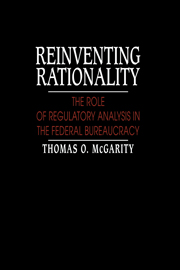Book contents
- Frontmatter
- Contents
- Acknowledgments
- Abbreviations
- Introduction
- Part I The clash of regulatory cultures
- Part II Regulatory analysis in theory and practice
- Part III Structuring regulatory analysis into the decisionmaking process
- 11 Roles for the regulatory analyst
- 12 The hierarchical model
- 13 The outside advisor model
- 14 The team model
- 15 The adversarial model
- 16 A hybrid model
- 17 Selecting the right model
- Part IV Review of regulatory analysis
- Part V Conclusions
- Notes
- Bibliography
- Index
13 - The outside advisor model
Published online by Cambridge University Press: 16 October 2009
- Frontmatter
- Contents
- Acknowledgments
- Abbreviations
- Introduction
- Part I The clash of regulatory cultures
- Part II Regulatory analysis in theory and practice
- Part III Structuring regulatory analysis into the decisionmaking process
- 11 Roles for the regulatory analyst
- 12 The hierarchical model
- 13 The outside advisor model
- 14 The team model
- 15 The adversarial model
- 16 A hybrid model
- 17 Selecting the right model
- Part IV Review of regulatory analysis
- Part V Conclusions
- Notes
- Bibliography
- Index
Summary
A second model of the regulatory analysis process casts the regulatory analyst in the role of outside advisor. In this model, the agency devotes a separate office at least in part to regulatory analysis, but it has no formal role in the decisionmaking process. It lacks institutional power, because it is not necessarily included in subordinate decisionmaking entities and because it does not have “sign-off” authority. The office is usually called in to provide information and analysis for large or controversial rulemaking efforts. Under this model, the regulatory analysis office speaks only when spoken to.
The outside advisor model in the Animal and Plant Health Inspection Service
The Animal and Plant Health Inspection Service (APHIS), one of the regulatory agencies in the highly decentralized USDA, is responsible for protecting domestic plants and animals from pestilence and disease. The quarantine statutes that it administers date back to the late nineteenth century. Under the more recent Federal Plant Pest Act, APHIS issues permits for the import and transport within the United States of plant pests and plants containing plant pests. In addition, APHIS licenses veterinary biological products, such as animal vaccines, to ensure that they meet agency standards for purity, safety and efficacy.
APHIS has two program offices: the Plant Protection and Quarantine Office and the Veterinary Services Office. The former deals with plant protection; the latter is responsible for animal protection. The agency's four regulatory analysts are lodged in the Policy Analysis and Program Evaluation Staff (the Policy Analysis Staff).
- Type
- Chapter
- Information
- Reinventing RationalityThe Role of Regulatory Analysis in the Federal Bureaucracy, pp. 200 - 208Publisher: Cambridge University PressPrint publication year: 1991



